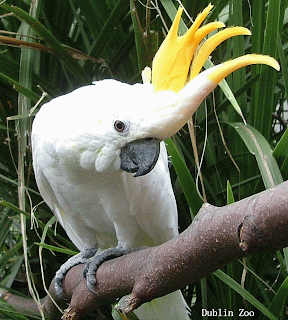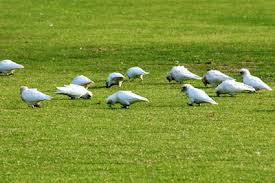Las cacatúas (Cacatuidae sp.) son aves originarias de las selvas y los bosques de Oceanía y Asia. Existen más de 15 especies, que se diferencian por el color de su cuerpo y el de su copete. Son "parientes" de los papagayos, pero son más grandes y tienen un plumaje suave, aunque colorido.
Viven en las copas de los árboles a los que trepan con la ayuda del pico y las patas. Se alimentan de frutos, semillas y larvas de insectos, que hallan en las maderas secas.
Aprovechan los huecos de los árboles o de los acantilados para hacer sus nidos. Sobre la cabeza, tienen un copete de plumas retráctiles que se extienden o repliegan para mostrar sus emociones y cortejar a las hembras.
Es muy difícil distinguir a las hembras de los machos. En algunos casos, la diferencia es el color de las plumas o el largo de la cola. Hay especies en las que las hembras tienen los ojos marrones, y los machos, negros.
Su pico es curvo y fuerte, semejante al de los loros y los papagayos, y les permite abrir las cáscaras de las semillas con facilidad. Suelen picotear trocitos de madera para desgastarlo.
Les gusta vivir en grupos de cientos de individuos, pero en la época de cría eligen vivir en pareja. Cuando una hembra pone los huevos en el nido, el macho se turna con ella para incubarlos.
Sus patas cuentan con dos dedos dirigidos hacia delante y uno hacia atrás que les sirven para trepar y sostener los alimentos.
Viven grupos llamados colonias. Son muy organizados, hasta se distribuyen las tareas: mientras algunas buscan alimento en el suelo, otras vigilan desde las alturas. En caso de peligro, alertan a los demás con un fuerte chillido.
Las hembras, suelen poner entre dos y tres huevos. Los pichones recién nacidos dependen completamente del cuidado de sus padres.
Del huevo a la madurez: después de la puesta, el polluelo tarda un mes en salir del huevo. En el momento del nacimiento, carece de plumas y tiene los ojos cerrados. Tres semanas después abre los ojos y comienza a tener plumas que parecen púas. El pico empieza a endurecerse, al mes, logra tener control de su cuerpo, se yergue y estira su cuello para recibir los alimentos. Un mes y medio después, el plumaje está completo y el copete se hace notorio. En un tiempo, el pichón ensayará sus primeros vuelos.
En cautiverio, tanto las cacatúas como los periquitos necesitan atención permanente de sus dueños. Muchas personas les cortan las alas y los dejan libres dentro de la casa para que sientan que tienen más espacio. Como son animales que en la naturaleza viven en grupos, les encanta "charlar" con su imagen reflejada en el espejo.
Cockatoos (Cacatuidae sp.) Are birds native to the jungles and forests of Oceania and Asia. There are more than 15 species, which are differentiated by the color of their body and their topknot. They are "relatives" of the parrots, but are larger and have a soft plumage, but colorful. They live in the tops of the trees that climb with the help of the beak and feet. They feed on fruits, seeds and insect larvae, which are in the dry woods. Use the existing holes in trees or cliffs for nesting. On the head, have a tuft of feathers extending or retracting retreat to show emotion and courting females. It is very difficult to distinguish females from males. In some cases, the difference is the color of the feathers or tail length. There are species in which females have brown eyes, and males, blacks. Its beak is curved and strong, similar to the parrots and macaws, and allows them to open the shells of seeds easily. They usually pick to wear him down wood chips. They like to live in groups of hundreds of individuals, but in the breeding season choose to live as a couple. When a female lays eggs in the nest, the male takes turns with her to incubate. Their feet have two toes pointing forward and one step back that I used to climb and hold food. Living groups called colonies. They are very organized, to be distributed tasks: while some foraging on the ground, others watch from above. In case of danger, warn others with a loud shriek. Females, usually put two or three eggs. The newborn chicks are completely dependent on parental care. From egg to maturity: after sunset, the chick takes a month to hatch. At the time of birth, no feathers and eyes are closed. Three weeks later he opens his eyes and begins to have feathers that look like spikes. The peak begins to harden, a month, manages to take control of his body, stands and stretches his neck to receive food. A month and a half later, the plumage is complete and the crest is noticeable. At one time, the pigeon tested their first flights. In the wild, cockatoos and parakeets need constant attention from their owners. Many people cut their wings and left free inside the house so they feel they have more space. How are animals in the wild live in groups, they love to "chat" with her reflection in the mirror.






No hay comentarios:
Publicar un comentario